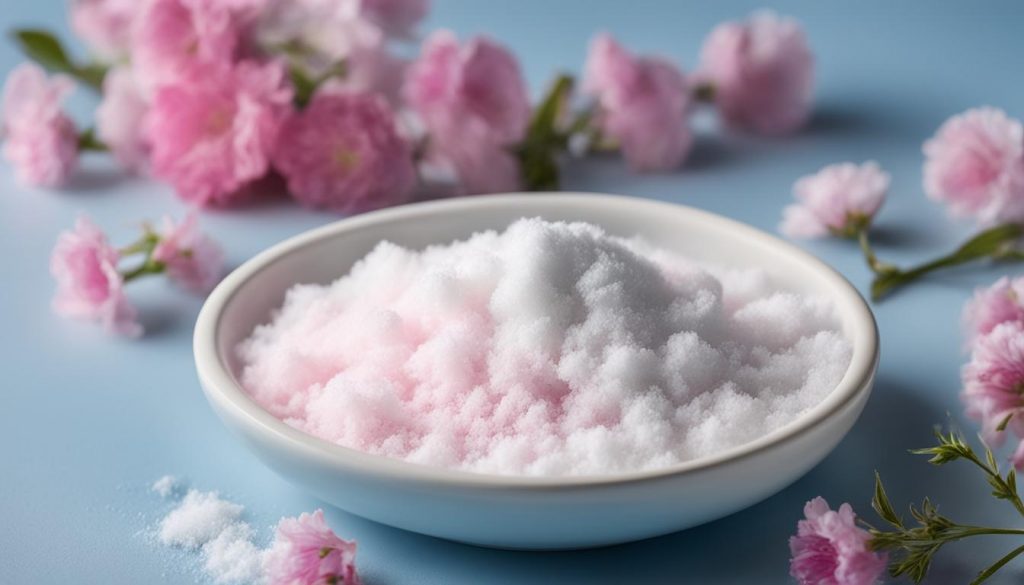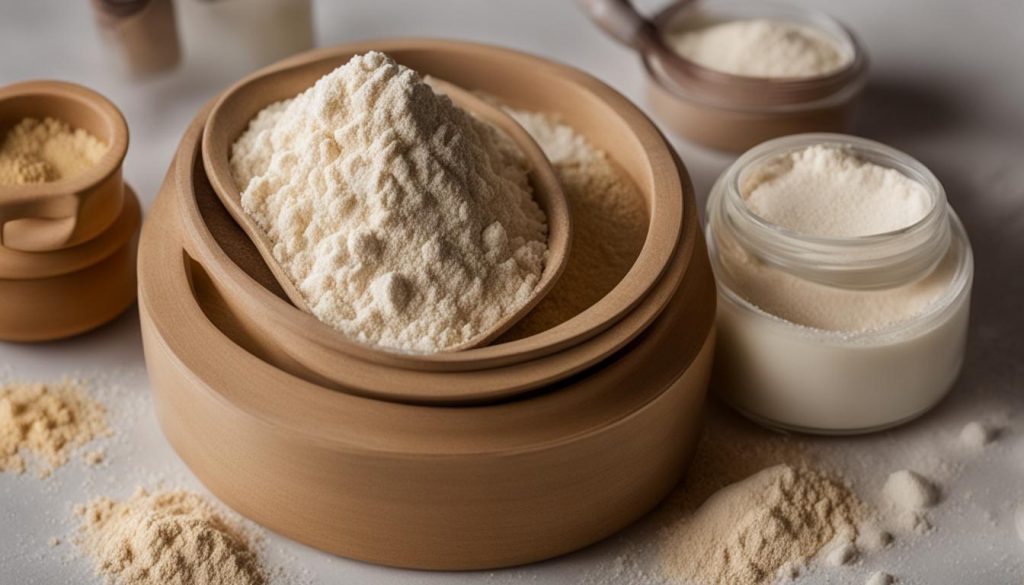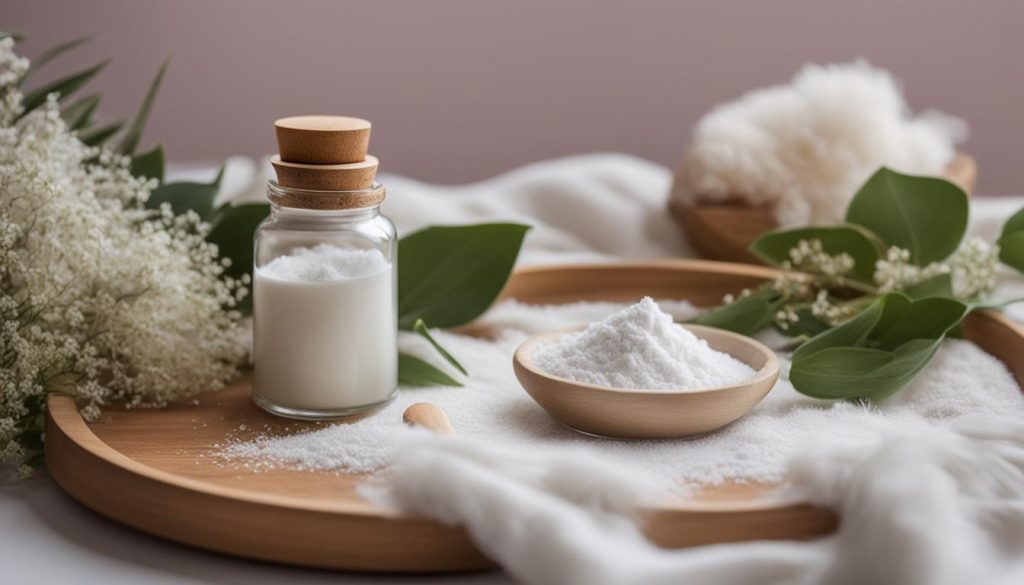Baby powder is a staple on changing tables for many parents, providing multiple benefits in infant care. It is typically made from talc or cornstarch and is used to absorb moisture and reduce friction on the skin, preventing rashes, including diaper rash. However, the American Academy of Pediatrics recommends against using baby powder, as it can irritate a baby’s delicate skin and pose inhalation risks. There are safer alternatives available for preventing diaper rash and maintaining good infant hygiene.
Key Takeaways:
- Baby powder has long been used for its moisture-absorbing properties and prevention of diaper rash.
- The American Academy of Pediatrics advises against using baby powder due to potential skin irritation and inhalation risks.
- Talcum-based and cornstarch-based baby powders are the two main types available, with fragrance often added for a pleasant scent.
- There are safer alternatives to baby powder, such as frequent diaper changes and the use of petroleum- or zinc-oxide-based creams.
- Consulting a pediatrician is recommended for newborn skin care and choosing suitable products for your baby’s specific needs.
Understanding Baby Powder Ingredients
Baby powder is available in two main types: talcum-based and cornstarch-based. Talcum-based baby powder contains talc, which is known for its moisture-absorbing properties, along with fragrance for a pleasant scent. Cornstarch-based baby powder, on the other hand, uses cornstarch as the primary ingredient, providing similar absorbing qualities. Fragrance is added to both types of powder to achieve the familiar baby scent. It’s important to read the labels to determine the ingredients in the baby powder you choose for your child.
While talcum-based baby powder is widely used, it’s crucial to be aware of the potential risks associated with talc. Talc, a naturally occurring mineral composed of magnesium, silicon, and oxygen, has been linked to respiratory problems and concerns about its safety when used on or near the genital area. Some studies have suggested a potential connection between talc and ovarian cancer, although this link remains uncertain and requires further research.
Cornstarch-based baby powder, on the other hand, presents a safer alternative. Made from finely ground corn kernels, cornstarch is hypoallergenic and less likely to cause skin irritation. It effectively absorbs moisture, keeping the baby’s skin dry and reducing the risk of diaper rash. Choosing a fragrance-free version is advisable to minimize the potential for skin sensitivities.
Image: Baby powder ingredients
The Potential Risks of Fragrance
It’s important to note that while fragrance adds a pleasant scent to baby powder, it can be a potential irritant for some babies. Babies have delicate and sensitive skin, and certain fragrances may cause allergic reactions or skin irritations. If your baby has a known sensitivity to fragrances or experiences any adverse reactions, it’s best to opt for fragrance-free baby powder options. Always consult with your pediatrician if you have any concerns about choosing the right baby powder for your child.
Choosing the Right Baby Powder
When selecting a baby powder, consider your baby’s specific needs and any potential sensitivities. Read the labels carefully to understand the ingredients, fragrance content, and any associated risks. If you’re unsure, consult with your pediatrician for guidance. Remember, baby powder should be used sparingly, avoiding direct application near the baby’s face and taking necessary precautions to prevent inhalation. Overall, prioritizing the health and safety of your baby’s delicate skin should guide your decision in choosing the right baby powder.
Safety Considerations for Baby Powder
When it comes to using baby powder, safety is a top priority. There are several important considerations to keep in mind to ensure the well-being of your child. Firstly, inhalation risks should be minimized. It is best to avoid using baby powder around the baby’s face or in large amounts to prevent the inhalation of potentially harmful particles. Instead, focus on applying the powder to areas where moisture and friction occur, such as the diaper area or under the arms.
Another safety concern associated with baby powder is the potential link to ovarian cancer. While studies have raised concerns, the connection between talc-based baby powder and ovarian cancer remains uncertain. To mitigate any potential risks, many experts recommend opting for talc-free alternatives. These talc-free powders offer a safer option for parents concerned about their child’s well-being. It’s important to read labels and choose products that clearly state they are talc-free.
To summarize the safety considerations for baby powder:
- Avoid using baby powder around the baby’s face or in large amounts to prevent inhalation risks.
- Consider using talc-free powders as a safer alternative to talc-based baby powder.
- Read labels carefully and choose products that clearly state they are talc-free.
By keeping these safety considerations in mind, parents can make informed choices about the use of baby powder and ensure the well-being of their child.
Alternatives to Baby Powder
When it comes to caring for your baby’s delicate skin, it’s important to choose safe and hypoallergenic alternatives to traditional baby powder. These alternatives not only help prevent diaper rash but also cater to sensitive skin, ensuring your little one stays comfortable and irritation-free.
One popular alternative to baby powder is the use of petroleum-based creams. These creams act as a protective barrier, preventing moisture from irritating the skin and causing rashes. Petroleum-based creams are gentle and effective, making them a reliable choice for diaper rash prevention. Simply apply a thin layer to the baby’s clean, dry skin during each diaper change.
If you’re looking for a more natural alternative, there are hypoallergenic powders specifically formulated for sensitive skin. These powders are fragrance-free and made with gentle ingredients to minimize the risk of irritation. They provide moisture absorption without the potential risks associated with traditional baby powder. Remember to always read the labels and choose products that are suitable for your baby’s specific needs.
| Alternatives to Baby Powder | Benefits |
|---|---|
| Petroleum-based creams | Protective barrier against moisture |
| Hypoallergenic powders | Gentle and fragrance-free |
Expert Opinions and Recommendations
When it comes to the use of baby powder, experts, including pediatricians and the American Academy of Pediatrics, have expressed concerns about its safety. Due to potential inhalation risks and the unresolved debate surrounding the link between talcum powder and cancer, it is recommended to avoid using traditional baby powder.
Instead, pediatricians emphasize the importance of frequent diaper changes as a key aspect of infant hygiene. Regularly changing the baby’s diaper helps to keep their skin dry and reduces the risk of developing diaper rash. It is also recommended to allow the baby’s bottom to air out whenever possible, as this promotes better airflow and prevents the buildup of moisture.
“Frequent diaper changes and proper hygiene practices are essential for ensuring the well-being of your child,” says Dr. Emily Thompson, a pediatrician specializing in infant care. “Using petroleum- or zinc-oxide-based creams as a protective barrier can also help prevent diaper rash and maintain healthy skin.”
In addition to these recommendations, parents can choose talc-free powders as an alternative to traditional baby powder. Talc-free powders are made with ingredients like cornstarch or arrowroot powder, providing similar moisture-absorbing properties without the potential risks associated with talc.
Pediatric Recommendations:
- Opt for frequent diaper changes to keep the baby’s skin dry and reduce the risk of diaper rash.
- Allow the baby’s bottom to air out whenever possible to promote better airflow and prevent moisture buildup.
- Use petroleum- or zinc-oxide-based creams as a protective barrier against diaper rash.
- Choose talc-free powders as a safer alternative to traditional baby powder.
| Talcum-based Baby Powder | Talc-Free Powder | |
|---|---|---|
| Ingredients | Talc and fragrance | Cornstarch or arrowroot powder |
| Moisture Absorption | Effective | Effective |
| Safety Concerns | May pose inhalation risks and potential link to cancer | Talc-free and considered safer |
| Recommended Usage | Not recommended by experts | Safe alternative |
By following these expert recommendations, parents can prioritize their baby’s well-being and maintain good infant hygiene without the need for traditional baby powder.
Johnson & Johnson Controversy

The controversy surrounding the safety of talc-based baby powder has led to numerous lawsuits against Johnson & Johnson. These lawsuits have alleged a connection between talc-based baby powder and an increased risk of cancer, particularly ovarian cancer. In response to these concerns and legal battles, Johnson & Johnson made the decision to permanently discontinue the sale of talc-based baby powder in the United States and Canada.
This decision signifies the significance of the ongoing debate surrounding the safety of talc-based baby powder. While the removal of talc-based products from the market demonstrates a proactive approach by the company, it also highlights the need for caution when using such products on infants.
“The discontinuation of talc-based baby powder by Johnson & Johnson reflects the growing concern over the potential health risks associated with these products. The link between talc and cancer remains debated, but the decision to remove talc-based powder from the market shows an acknowledgment of the need for safer alternatives.”
Key Points:
- Johnson & Johnson has discontinued the sale of talc-based baby powder in the U.S. and Canada due to ongoing lawsuits and concerns about cancer risks.
- The decision highlights the need for caution when using talc-based baby powder on infants.
- Experts have emphasized the importance of seeking safer alternatives to talc-based baby powder for infant care.
| Product | Safety Concerns | Availability |
|---|---|---|
| Talc-based Baby Powder | Potential cancer risks | Discontinued in the U.S. and Canada |
| Cornstarch-based Baby Powder | Considered safer | Continues to be available |
While cornstarch-based baby powder is still available as an alternative, it is essential for parents to carefully evaluate the potential risks and benefits of any baby powder product they choose to use.
The Truth About Talc and Cancer
There has been ongoing research and debate surrounding the potential link between talc and cancer, particularly ovarian cancer. Talcum powder, which is made from talc, a mineral that may contain asbestos, has been a subject of concern. While talcum products have been asbestos-free since the 1970s, the question of whether talc itself poses a risk remains unanswered. Some studies suggest an increased risk of ovarian cancer with regular talcum powder use, while others find no significant association.
It is important to note that research findings on this topic have not yet provided a clear consensus. The connection between talc and cancer requires more extensive research to fully understand its impact. Until more conclusive evidence is available, caution is advised when using talcum powder, especially in areas where it can be easily inhaled or on sensitive areas of the body.
“The potential link between talc and cancer, particularly ovarian cancer, remains a subject of research and debate.”
While the debate continues, it is essential for consumers to stay informed and make educated decisions about their personal care choices. It is always a good idea to explore other options and consider talc-free alternatives that have been specifically formulated to provide similar benefits without the potential risks associated with talcum powder.
Summary of Research Findings on Talc and Cancer Risk
| Study | Findings |
|---|---|
| Study 1 | No significant association found between talcum powder use and ovarian cancer risk. |
| Study 2 | Regular use of talcum powder may increase the risk of ovarian cancer, particularly when applied to the genital area. |
| Study 3 | Inconclusive results, with no clear link established between talc and ovarian cancer. |
As the research on talc and cancer risk continues, it is crucial for individuals to prioritize their health and well-being. Staying informed about the latest findings and consulting with healthcare professionals can help guide personal care decisions and minimize potential risks.
- Be cautious when using talc-based products, especially in areas where inhalation or direct contact with sensitive areas can occur.
- Consider talc-free alternatives that provide similar benefits, such as cornstarch-based baby powder or other absorbent substances.
- Stay up to date with the latest research findings on talc and cancer risk and consult with healthcare professionals for personalized advice.
Navigating Newborn Skin Care
When it comes to caring for your newborn’s delicate skin, it’s important to choose the right products and establish a gentle skincare routine. With a few key considerations and expert recommendations, you can ensure that your baby’s skin remains healthy and protected.
First and foremost, opt for mild cleansers specifically formulated for newborns. These cleansers are designed to be gentle on your baby’s sensitive skin, effectively removing impurities without stripping away natural oils. Look for fragrance-free products to minimize the risk of skin irritation and allergic reactions. Remember, your baby’s skin is delicate and may be more prone to dryness, so it’s essential to choose products that won’t disrupt the natural moisture balance.
“Using mild cleansers specifically formulated for newborns is crucial to keeping your baby’s skin healthy and protected.”
In addition to choosing the right cleansers, it’s important to be aware of common skin conditions that newborns may experience. Dry skin is common in infants and can be treated with gentle moisturizers or baby lotions. For more severe cases of dryness or conditions like eczema, consult with your pediatrician for appropriate treatment options.
When it comes to diaper rash prevention, petroleum jelly or zinc-oxide-based creams can provide a protective barrier against moisture. These products help to prevent friction and irritation, reducing the likelihood of diaper rash. Remember to change your baby’s diaper frequently and allow their bottom to air out to further minimize the risk of diaper rash.
| Common Skin Conditions | Treatment |
|---|---|
| Dry Skin | Gentle moisturizers or baby lotions |
| Eczema | Consult with a pediatrician for appropriate treatment options |
| Diaper Rash | Petroleum jelly or zinc-oxide-based creams |
By following these newborn skincare tips and using the appropriate products, you can help keep your baby’s skin healthy, soft, and free from irritations. Remember, every baby is unique, so if you have any concerns or questions about your baby’s skin, don’t hesitate to reach out to your pediatrician for personalized advice.
Conclusion
After careful consideration and expert advice, it is clear that baby powder is no longer recommended for infant care. The potential risks associated with inhalation and the potential link to cancer have led to a shift in recommendations. As parents, we must prioritize our babies’ safety and well-being by exploring safe alternatives and following expert recommendations.
Infant hygiene remains of utmost importance, and there are effective alternatives to baby powder available in the market. Pediatricians suggest frequent diaper changes to keep the baby’s skin dry and healthy. Allowing the baby’s bottom to air out is also an essential step in preventing diaper rash. Instead of traditional baby powder, petroleum- or zinc-oxide-based creams can be used as a protective barrier to safeguard against moisture.
For babies with sensitive skin, hypoallergenic alternatives to baby powder are a suitable choice. These specially formulated products are gentle on the skin and offer the same benefits without the risks associated with traditional baby powder. However, it is always advisable to consult a pediatrician before introducing any new products to a baby’s delicate skin.
By following these expert recommendations and utilizing safe alternatives, parents can ensure the optimal infant hygiene and the well-being of their child. As the understanding of baby care evolves, it is crucial for parents to stay informed and make decisions that prioritize the health and safety of their little ones.
FAQ
Is baby powder safe for infants?
The American Academy of Pediatrics advises against using baby powder due to safety concerns. There are alternative products available that are considered safer for infant care.
What are the main ingredients in baby powder?
Baby powder is typically made from either talc or cornstarch, along with fragrance for a pleasant scent. It’s important to check the label to determine the ingredients in the specific baby powder you choose.
Are there any risks associated with using baby powder?
Baby powder poses inhalation risks for infants and has been linked to potential ovarian cancer in adult women. It’s best to avoid using large amounts of baby powder and opt for talc-free alternatives to ensure safety.
What are the alternatives to baby powder?
There are several alternatives to baby powder, such as frequent diaper changes, allowing the baby’s bottom to air out, and using petroleum- or zinc-oxide-based creams for diaper rash prevention. Hypoallergenic alternatives are also available for babies with sensitive skin.
What do experts recommend for infant hygiene?
Experts, including the American Academy of Pediatrics, advise against using baby powder. They recommend talc-free powders or alternative products, frequent diaper changes, and the use of petroleum- or zinc-oxide-based creams as a protective barrier.
What is the controversy surrounding Johnson & Johnson’s baby powder?
Johnson & Johnson faced numerous lawsuits linking talc-based baby powder to cancer. As a result, the company has decided to discontinue the sale of talc-based baby powder in the U.S. and Canada.
Is there a link between talc and cancer?
While talcum products have been asbestos-free since the 1970s, research on the potential link between talc and cancer, particularly ovarian cancer, is still ongoing. Some studies suggest a possible increased risk, while others find no significant association.
How should I care for my newborn’s skin?
Newborn skin care requires special attention. It is recommended to use mild cleansers and avoid products with fragrances and dyes to prevent skin irritation and respiratory issues. Diaper rash ointments, petroleum jelly, and baby lotions can be used to treat common skin conditions like dry skin, eczema, and diaper rash.





